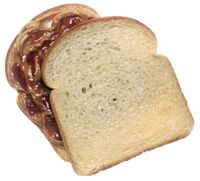Food rheology
Topic: Physics
 From HandWiki - Reading time: 3 min
From HandWiki - Reading time: 3 min
Food rheology is the study of the rheological properties of food, that is, the consistency and flow of food under tightly specified conditions.[1] The consistency, degree of fluidity, and other mechanical properties are important in understanding how long food can be stored, how stable it will remain, and in determining food texture. The acceptability of food products to the consumer is often determined by food texture, such as how spreadable and creamy a food product is. Food rheology is important in quality control during food manufacture and processing.[2] Food rheology terms have been noted since ancient times. In ancient Egypt, bakers judged the consistency of dough by rolling it in their hands.[3]
Overview
There is a large body of literature on food rheology because the study of food rheology entails unique factors beyond an understanding of the basic rheological dynamics of the flow and deformation of matter. Food can be classified according to its rheological state, such as a solid, gel, liquid, emulsion with associated rheological behaviors, and its rheological properties can be measured.[4] These properties will affect the design of food processing plants, as well as shelf life and other important factors, including sensory properties that appeal to consumers. Because foods are structurally complex, often a mixture of fluid and solids with varying properties within a single mass, the study of food rheology is more complicated than study in fields such as the rheology of polymers.[5] However, food rheology is something we experience every day with our perception of food texture (see below) and basic concepts of food rheology well apply to polymers physics, oil flow etc. For this reason, examples of food rheology are didactically useful to explain the dynamics of other materials we are less familiar with. Ketchup is commonly used an example of Bingham fluid and its flow behavior can be compared to that of a polymer melt.[6]
Psychorheology
Psychorheology is the sensory judgement of rheological properties. It is a term used in the food industry, to describe how a food "feels" to the mouth. It is not necessarily straightforward to predict how a food will "feel" based purely on the true rheological properties.[7]
The most important factor in food rheology is consumer perception of the product. This perception is affected by how the food looks on the plate as well as how it feels in the mouth, or "mouthfeel". Mouthfeel is influenced by how food moves or flows once it is in a person's mouth and determines how desirable the food is seen to be.[1]
See also
- Aseptic processing
- Cosmetics
- Dietary supplement
- Food and Bioprocess Technology
- Food chemistry
- Food Engineering
- Food fortification
- Food grading
- Food microbiology
- Food packaging
- Food preservation
- Food safety
- Food science
- Food storage
- Food supplements
- Food technology
- Nutraceutical
- Nutrification (aka food enrichment or fortification)
- Pharmaceuticals
Notes
- ↑ 1.0 1.1 B.M. McKenna, and J.G. Lyng (2003). Texture in food > Introduction to food rheology and its measurement. pp. 2–3. ISBN 9781855736733. https://books.google.com/books?id=wM1asp1LL8EC&q=Food+Rheology&pg=PA130. Retrieved 2009-09-18.
- ↑ Peter K.W. Herh, Steven M. Colo, Nick Roye, and Kaj Hedman (2000). "Rheology of foods: New techniques, capabilities, and instruments". Circle Reader Service. http://www.atsrheosystems.com/PDF%20files/Food%20Paper.pdf.
- ↑ Brummer, Rüdiger (2006). Rheology Essentials of Cosmetic and Food Emulsions > Excursion in the World of Food Rheology. www.springerlink.com. doi:10.1007/3-540-29087-7_13.
- ↑ Rao, M. A. (2007). Rheology of fluid and semisolid foods: principles and applications. Springer. p. 1. ISBN 9780387709307. https://books.google.com/books?id=RYE586GZtRsC&q=Food+Rheology&pg=PA1. Retrieved 2009-09-18.
- ↑ Taylor, Steve L. (1996). Advances in food and nutrition research. Academic Press. p. 3. ISBN 9780080567846. https://books.google.com/books?id=snSQOv-NR8oC&q=Food+Rheology&pg=PA3. Retrieved 2009-09-19.
- ↑ "Rheology Experiments for Master students". Aix-Marseille University - Course of Rheology. http://giandonet.altervista.org/Marco/Rheology/experimental%20rheology%20TP.html.
- ↑ Szczesniak A. S. (December 1991). "Psychorheology and texture as factors controlling the consumer acceptance of food". Cereal Foods World 35 (12): 1201–1205.
References
- Brummer, Rüdiger (24 August 2005). Rheology essentials of cosmetic and food emulsions > Excusion in the World of Food Rheology. Brummer. ISBN 9783540255536. https://books.google.com/books?id=HhLooJy2NcAC&q=Food+Rheology&pg=PA161. Retrieved 2009-09-19.
- Heldman, Dennis R. (29 August 2003). Encyclopedia of agricultural, food and biological engineering. CRC. ISBN 9780824709389. https://books.google.com/books?id=fCRpUZzT2hMC&q=Food+Rheology&pg=PA921. Retrieved 2009-09-18.
- Kutz, Myer (2008). Handbook of Farm, Dairy, and Food Machinery. William Andrew Publishing. ISBN 978-0-8155-1538-8. https://books.google.com/books?id=ulPrn_Rqt-kC&q=Food+Rheology&pg=PT421. Retrieved 2009-09-19.
 |
 KSF
KSF

